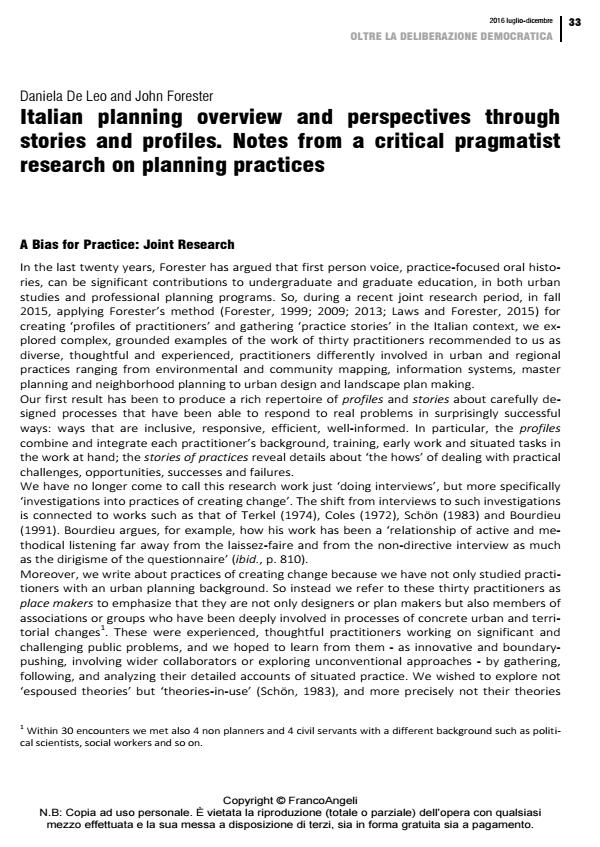Italian planning overview and perspectives through stories and profiles. Notes from a critical pragmatist research on planning practices A Bias
Titolo Rivista CRIOS
Autori/Curatori Daniela De Leo, John Forester
Anno di pubblicazione 2016 Fascicolo 2016/12 Lingua Inglese
Numero pagine 8 P. 33-40 Dimensione file 835 KB
DOI 10.3280/CRIOS2016-012004
Il DOI è il codice a barre della proprietà intellettuale: per saperne di più
clicca qui
Qui sotto puoi vedere in anteprima la prima pagina di questo articolo.
Se questo articolo ti interessa, lo puoi acquistare (e scaricare in formato pdf) seguendo le facili indicazioni per acquistare il download credit. Acquista Download Credits per scaricare questo Articolo in formato PDF

FrancoAngeli è membro della Publishers International Linking Association, Inc (PILA)associazione indipendente e non profit per facilitare (attraverso i servizi tecnologici implementati da CrossRef.org) l’accesso degli studiosi ai contenuti digitali nelle pubblicazioni professionali e scientifiche
During a recent joint research period, applying Forester’s method for creating "profiles of practitioners" and gathering "practice stories" in the Italian context, the authors explored the work of thirty Italian practitioners. They have come to call this research work no longer just "doing interviews" but more specifically "investigations into practices of creating change". By exploring not "espoused theories" but "theories-in-use", the authors have tried to close the epistemological and political gap between pragmatism and critical theory in the direction of a "critical pragmatism". Moreover, by considering the direct voices of these Italian practitioners, authors find relevant and pressing to discuss research outcomes in this journal where challenges about planning perspectives and the overcome of deliberative democracy are under discussion
- Bourdieu P. (1991). La misère du monde. Paris: Edition du Seuil (trad. it. 2015).
- Campbell H. (2014). The Academy and the Planning Profession: Planning to Make the Future Together? Planning Theory & Practice, 15, 119-122. DOI: 10.1080/146493572014.886801
- Coles R. (1972). Farewell to the South. Boston: Little Brown.
- Coles R. (1989). The Call of Stories. Boston: Houghton Mifflin.
- Crosta P. L. (1990). La politica del piano. Milano: FrancoAngeli.
- De Leo D. (2011). Public sphere and illegal settlements: a case from the Naples metro-region. In:
- Cremaschi M. and Eckardt F. (eds), Changing Places, Urbanity, Citizenship, and Ideology in the new European neighbourhoods. Amsterdam: Teckne, 199-220.
- De Leo D. (2013). Trading with enemies? The trading zone approach in successful planning processes in Sicily. In: Balducci A. and Mäntysalo R. (eds) Urban planning as a trading zone. Dordrecht: Springer, 125-142.
- De Leo D. (2016). Mafie & Urbanistica. Milano: FrancoAngeli.
- Dewey J. (1927). The Public and Its Problems. New York: Henry Holt.
- Dewey J. (1929). The Quest for Certainty. In: Boydston J.A. (ed.), John Dewey: Later Works. Vol. 4. Carbondale: Southern Illinois University Press, 1984.
- Forester J. (1993). Critical Theory, Public Policy, and Planning Practice: Toward a Critical Pragmatism. Albany: SUNY Press.
- Forester J. (1999). The Deliberative Practitioner. Cambridge: MIT Press.
- Forester J. (2012). Learning To Improve Practice: Lessons From Practice Stories and Practitioners’ Own Discourse Analyses (Or Why Only The Loons Show Up). Planning Theory and Practice, 13 (1), 11-26. DOI.10.1080/14649357.2012. 649905.
- Forester J. (2013). Planning in the Face of Conflict: Surprising Possibilities of Facilitative Leadership. Chicago: American Planning Association Press.
- Forester J. (2014). On the Evolution of a Critical Pragmatism, Workshop on the Evolution of Planning Thought. Vienna, May, 19-23.
- Friedmann J. (1987). Planning in the Public Domain: From Knowledge to Action. Princeton: Princeton University-Press.
- Greed C. H. (1994). Woman and Planning. London-New York: Routledge.
- Hoch C. (1994). What Planners Do. Chicago: American Planning Association Press.
- Kadlec A. (2007). Dewey’s Critical Pragmatism. Lanham, MD: Lexington Books.
- Krumholz N. and Forester J. (1990). Making Equity Planning Work. Philadelphia: Temple University Press.
- Laws D. and Forester J. (2015). Conflict, Improvisation, Governance. London-New York: Routledge.
- Majone G. (1992). Evidence, Argument, and Persuasion in Policy Process. New Haven CT: Yale University Press.
- Nussbaum M. (1990). Love's Knowledge. New York: Oxford.
- Rittel H. and Melvin W. (1973). Dilemmas in A General Theory of Planning. Policy Sciences, 4, 155-169. DOI: 10.1007/BF01405730
- Sandercock L. (2003). Out of the closet: The importance of story in planning practice. Planning Theory and Practice, 4, 11-28. DOI: 10.1080/1464935032000057209
- Schön D. (1983). The Reflective Practitioner. New York: Basic Books.
- Secchi B. (2011). La nuova questione urbana: ambiente, mobilità e diseguaglianze sociali. CriOS, 1, 83-92. DOI: 10.7373/70210
- Terkel S. (1974). Working. New York: New Press.
- Bologna, deleghe e pratiche composite Patrizia Gabellini, in TERRITORIO 82/2017 pp.40
DOI: 10.3280/TR2017-082009
Daniela De Leo, John Forester, Italian planning overview and perspectives through stories and profiles. Notes from a critical pragmatist research on planning practices A Bias in "CRIOS" 12/2016, pp 33-40, DOI: 10.3280/CRIOS2016-012004